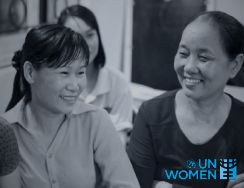Philippines
| Date of Accession/ Ratification: | 15 July 1980 (signed), 5 Aug 1981 (ratified) |
| Reservations: | None |
| Optional Protocol: | Ratified 12 November 2003 |
| Reporting Status: | - Initial report examined in 1984 - 2nd report examined in 1991 - 3rd and 4th combined reports examined at 16th Session, 1997 - 5th and 6th combined reports examined at 36th Session, 2006 - 7th and 8th combined reports due in 1st September 2010 |
| Shadow reports | Philippine NGOs Shadow Report submitted by Women’s Legal Bureau, INC |
| Concluding Observations | Concluding observations from 36th session |
| General Recommendations | General Recommendation No. 24: Article 12: Women and Health |
| Coordinating Agency for CEDAW implementation: | Commission on Human Rights (CHR) – Gender Ombudsman |
The Republic of the Philippines is a Southeast Asian nation made up of over 7,000 islands in the Pacific Ocean. Its history of colonization – first by Spain and then the United States English is one of its official languages, While greater majority of population are Roman Catholics, significant number of population are Protestants, Muslims and/or other faiths. With its fast growing population of 88.9 million in 2007 to 96.7 million in 2012, the Philippines is one of the most populous countries in Southeast Asia. Significant numbers of Filipinos are migrant workers abroad – in 2011, the number of overseas Filipinos workers amounted to over 10 million, with 1 million of those as irregular migrant workers. It is ranked 114 out of 187 countries and territories on the Human Development Index, and is above the medium human development average, however, below the average for East Asia and Pacific countries.
| Adopted legislation | Ratified international human rights treaties |
|
|
Figure 1 - Legislative measures and updates on the ratification status of
international human rights treaties since last CEDAW session in 2006
Alongside this however, remain persisting issues regarding the feminisation of migration, and the lack of bilateral agreements and memorandums of understanding between key countries and regions Filipino women migrate to. Women workers pursue employment opportunities through informal channels, and are subsequently victims of various forms of exploitation, violence and trafficking. This is further exacerbated with the implications of free trade, which negatively impacts employment opportunities for women in rural and remote areas. Unemployment rates and unequal wage gaps are prominent for women within the working sphere, and due to the overrepresentation of women in the informal economy, women are stigmatised, and often ineligible for social security and health care. There is also limited access to justice and impunity in cases of violence which often occur in conflict zones.
| Multidimensional Poverty Index Rank – MPI – (of 104 countries) – ‘head count’ (%) | From 2008 survey: 13.4 |
| Gender Inequality Index Rank – GII – (of 148 countries) | In 2012: 77 |
| Social Institutions and Gender Index – SIGI | In 2009: 7 (of 102 countries) In 2012: 12 (of 86 countries) |
There continues to be an imbalance of power relationships among men and women. The stereotyping of women’s roles in the public and family sphere continues to exacerbate their restrictions from exercising their rights, and divorce is illegal. The acknowledgement and protection reproductive and sex education is limited in the Philippines, particularly in rural areas, and consequently, there is a high maternal mortality rate, as well as deaths resulting from induced abortions. More information at CEDAW in Action - Philippines.
Supported by:
Latest news
At a glance

Getting to know more about CEDAW and the Regional Programme in Southeast Asia | CEDAW Brochure